Cases
Tachycardia
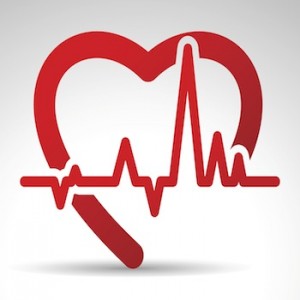 Muscles and joints of the neck can influence heart rate and blood pressure.
Muscles and joints of the neck can influence heart rate and blood pressure.
Research has shown that a pathway exists between neck muscles and a part of the brainstem (image below) called the nucleus tractus solitarius1 (NTS). Postural alterations to the spine or injured neck muscles can change the way the NTS works.
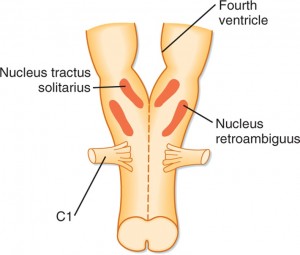 The NTS plays a crucial role in regulating heart rate and blood pressure. Not only does the NTS receive input from the spine (C1) and muscles, but it also responds to emotion and stress from the brain above. This is why both physical and mental stress can alter the heart.
The NTS plays a crucial role in regulating heart rate and blood pressure. Not only does the NTS receive input from the spine (C1) and muscles, but it also responds to emotion and stress from the brain above. This is why both physical and mental stress can alter the heart.
The NTS can induce sensations of nausea due to its connections with the vestibular system, hence why you feel nauseous when your spine is “out”. It also has intimate connections with the autonomic nervous system, influencing temperature fluctuations, flushing and sweating.
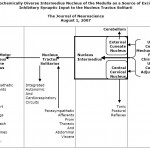 The upper neck, or upper cervical spine, is critical to how many systems in the body function. Chiropractors are at the forefront of a growing number of professions that pay attention to the spine and its role in health, wellness and disease prevention. Upper cervical chiropractors in particular specialise in the way this area influences the nervous system (click image to enlarge) ?
The upper neck, or upper cervical spine, is critical to how many systems in the body function. Chiropractors are at the forefront of a growing number of professions that pay attention to the spine and its role in health, wellness and disease prevention. Upper cervical chiropractors in particular specialise in the way this area influences the nervous system (click image to enlarge) ?
Clumsiness
Resolution of life-long clumsiness in a 9-year old boy over 6 weeks.
 Proprioception is the ability of your brain to sense the relative position of your body parts in space, and the ability to move your body accurately without having to look at what you are doing. Without accurate proprioception you would not be able to drive a car as you would need to constantly look at what your arms and legs were doing. When proprioceptive function is impaired, for instance not knowing precisely where your leg is when your eyes are closed, you are more likely to be clumsy and accident prone.
Proprioception is the ability of your brain to sense the relative position of your body parts in space, and the ability to move your body accurately without having to look at what you are doing. Without accurate proprioception you would not be able to drive a car as you would need to constantly look at what your arms and legs were doing. When proprioceptive function is impaired, for instance not knowing precisely where your leg is when your eyes are closed, you are more likely to be clumsy and accident prone.
Seemingly without effort, we adjust our movements to continuously changing environments. After initiation of a goal-directed movement, the motor command from the brain is under constant control of sensory feedback loops. The main sensory signals contributing to movement control are vision and proprioception. The posterior parietal cortex (rear part of the brain) plays a prominent role in processing sensory information for movement control. A recent study has shown that there is an area in this part of the brain which processes proprioceptive information only when coordinating your body1. This means that if the parietal cortex is not wired right, and you close your eyes, the clumsiness will be evident (see video below).
Chiropractic care assists brain function in many ways, one of which is proprioceptive function, and this improves the accuracy of the internal brain map so your brain knows exactly what is going on all the time. This process of accurately wiring the brain is especially important during childhood as the brain matures through to age twenty ? read more…
Dysautonomia
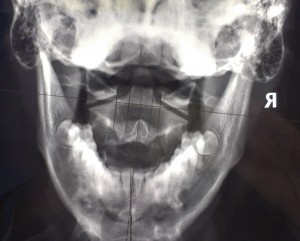 16-year old male presents with acute dysautonomia following a fall from a horse.
16-year old male presents with acute dysautonomia following a fall from a horse.
Dysautonomia is characterised by malfunction of the autonomic nervous system (ANS). The ANS controls heart rate, temperature, digestion and blood pressure, and it can cause lightheadedness and fainting.
Symptoms can also include extremely fast heart rate, slow heart rate, palpitations, chest pain, dangerously low or wide swings in blood pressure, the inability to remain upright, excessive fatigue, gastrointestinal problems, nausea, insomnia, shortness of breath, anxiety, tremulousness, frequent urination, convulsions, and migraines.
At Spinewave the ANS is assessed via observation, cranial nerve exam, thermographic and heart rate variability examination.
5 months following a 2m fall from a horse, the patient developed daily reflux and vomiting, temperature fluctuations and sweating, palpitations, dizziness and vertigo, asthma, hives, photosensitivity and hyperlacrimation (excessive tearing), acne, tinnitus and chronic daily headache.
Patient was being medicated daily for reflux, asthma and hypersensitivity reactions with losec, ranitidine, bricanyl, symbicort, and prednisone. Prior to the fall from the horse, none of these symptoms existed.
5 weeks following upper cervical specific chiropractic care, patient reported complete resolution of all complaints and is medication free.
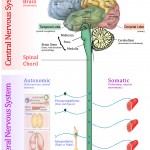 This case illustrates the anatomical importance of appropriate spinal function and corresponding state of the autonomic nervous system (click image to enlarge).
This case illustrates the anatomical importance of appropriate spinal function and corresponding state of the autonomic nervous system (click image to enlarge).
The activity of the ANS is a result of the summation of integrative processes in the spinal cord, brainstem, hypothalamus and forebrain. Spinal autonomic circuits are essential in modulating descending signals of functional activity.
Sometimes “spinal shock” can cause autonomic dysreflexia, leading to increased activation of vasculature and skin, arterial blood pressure and heart rate, sweat glands, bladder and other targets of the ANS1.
Evaluating appropriate spinal function is imperative in cases of autonomic dysfunction following any kind of trauma to the head and neck because the spinal cord is an autonomic organ in its own right. Neurons projecting from brainstem and hypothalamus to the spinal cord synapse with autonomic neurons.
© Spinewave 2013
Reference:
- Jänig, W. Integrative Action of the Autonomic Nervous System: Neurobiology of Homeostasis. 2008. Cambridge University Press.
Polio
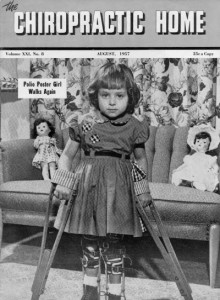 This is not a case of “chiropractic cures polio”. This is a historical perspective on disease and prevention.
This is not a case of “chiropractic cures polio”. This is a historical perspective on disease and prevention.
During the 1900s there was a global decline in death rates from all major infectious disease (typhoid, smallpox, scarlet fever, measles, whooping cough, diptheria, influenza, tuberculosis, pneumonia, diseases of the digestive system and poliomyelitis) due to improvements in environmental sanitation, particularly water purification and sewage disposal; better housing, clothing and nutrition.
In the late 20th century, children whose living standards were poor were more susceptible to infectious diseases than their more advantaged peers. We see this disparity today between first and third world countries.
The subject of vaccination and preventable disease is a loaded topic because the decline in death from infectious disease began long before the introduction of any prophylaxis or “preventative medicine”, plus data can be viewed at different angles depending on the researcher’s bias.
 In 1955, a graph from the Immunet website showed 40,000 cases of polio in NZ when in fact there were only 703 cases1. At first glance, the polio graph shows a dramatic decrease in the incidence of polio immediately following the introduction of the Salk vaccine, however, the data is not actually from NZ. It’s from the United States. The peak incidence of polio in NZ only ever reached 1159 in 1925. The provision of this data to New Zealanders without specifying the country of origin was tantamount to scaremongering.
In 1955, a graph from the Immunet website showed 40,000 cases of polio in NZ when in fact there were only 703 cases1. At first glance, the polio graph shows a dramatic decrease in the incidence of polio immediately following the introduction of the Salk vaccine, however, the data is not actually from NZ. It’s from the United States. The peak incidence of polio in NZ only ever reached 1159 in 1925. The provision of this data to New Zealanders without specifying the country of origin was tantamount to scaremongering.
This tactic has been used again and again. In recent times we recall the MeNZB (meningococcal) campaign, ultimately halted due to the “epidemic ending”. Then there was the highly controversial Gardasil campaign for cervical cancer – a vaccine they intended to extend to boys. Motives start becoming questionable. Fortunately though we live in the Information Age now where these things can be questioned, because medical practice questions itself. read more…
Disrupted Sleep
 Sleep loss affects the stress systems in our bodies and is important because these systems enable us to deal with everyday challenges. The two stress systems are the autonomic nervous system and the hypothalamic-pituitary-adrenal axis, as they both relate to the adrenal glands.
Sleep loss affects the stress systems in our bodies and is important because these systems enable us to deal with everyday challenges. The two stress systems are the autonomic nervous system and the hypothalamic-pituitary-adrenal axis, as they both relate to the adrenal glands.
These two systems together impact our overall health and how we respond to stress. They are responsible for energy balance, delivery of fuel and oxygen to all parts of the body and muscles, and appropriate balance of sugars and hormones.
Lack of sleep, which can be cumulative over a long period of time, puts the body into a subconscious state of stress. This makes one more prone to sickness, chronic fatigue, pain, cardiovascular problems like high blood pressure, mental health problems like depression or anxiety, and even changes in brain plasticity and ageing1.
Because disrupted sleep affects the autonomic nervous system (one of the stress systems), it alters pain perception. People become more sensitive to pain2. Why this occurs is because the main nerve cell bodies associated with the autonomic nervous system reside in the brainstem, and the brainstem is responsible for processing sleep. Lack of sleep disrupts the way the brainstem works and alters feel-good chemical outflow like serotonin, as well as increasing inflammation. Reduced serotonin and increased inflammation is what can lead to depression and why people feel miserable when they’re tired. Antidepressants might be prescribed in this situation but are not a sustainable solution.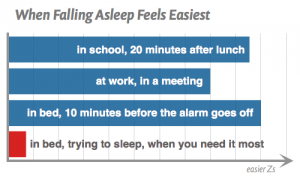
Sleep has a mild suppressive effect on the body’s stress systems. Disrupted sleep elevates the activity of these systems and if sleep deprivation is accrued over time, stress levels don’t actually return to baseline: Each day they build up, making health problems worse.
People commonly associate lack of sleep with emotional change, however, don’t see the underlying changes to the autonomic nervous system and hormonal systems.
Most of the phenomenal changes seen in clinical chiropractic practice are due to the effects chiropractic has on the autonomic nervous system3,4,5. Many people are not aware they even have an autonomic nervous system, but if you can measure it, you can change it. Normalising the stress systems through specific adjustments to the spine helps people sleep better and reduce overall pain sensitivity ? read more…
Double Frozen Shoulder
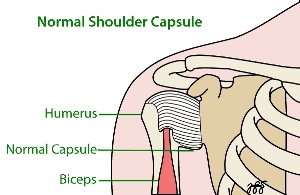 Frozen shoulder is common, yet poorly understood. For most people who get frozen shoulder, the onset is idiopathic – meaning of unknown cause.
Frozen shoulder is common, yet poorly understood. For most people who get frozen shoulder, the onset is idiopathic – meaning of unknown cause.
For any condition where the cause is unknown, or when an individual finds themselves just “waking up one morning” host to a problem, you’re thinking chronic condition; you’re thinking long term build up; nervous system based issue; inflammatory and or autoimmune condition.
Nothing ever “just happens”. The human body walks a fine line of homeostasis (balance) and the things we do, think, eat, drink or say affects that biology over time (whether you believe it or not).
The body always keeps score. Inflammation causes most of the same changes in the brain and body that have been repeatedly observed in animals and humans exposed to stress, especially when the stress is chronic and of a psychosocial nature1. Inflammation can cause any number of problems in the body: where and how is dependent upon your nervous system’s particular wiring. Your nervous system is like a glass of water. How much stress and inflammation it can handle is finite. Eventually the glass will overflow.
“Adhesive capsulitis” is the term given to frozen shoulder because the shoulder capsule becomes stuck and inflamed. The capsule is like cling film which vacuum packs the shoulder joint. The shoulder “freezes” and movement becomes limited, difficult and painful. The underlying pathology of frozen shoulder is chronic inflammation of the synovial capsule (the cling film) and reactive capsular fribrosis2 (the formation of adhesions).
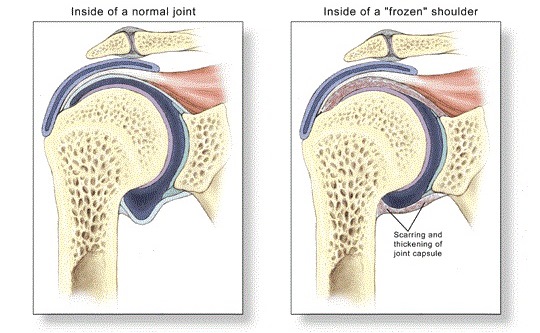
Frozen shoulder is a “system” problem, not just a “shoulder” problem. Simply exercising and stretching the shoulder alone will not help without addressing the underlying neuroimmune issues.
Frozen shoulder typically goes through 3 stages: Freezing (painful), frozen (stiff), and thawing (resolving) – click here for more. This journey can potentially last up to 2 years. However, that timeline depends totally on you and the specific kind of treatment received.
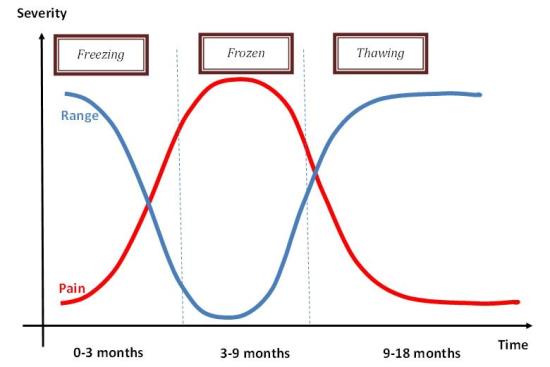
Asthma
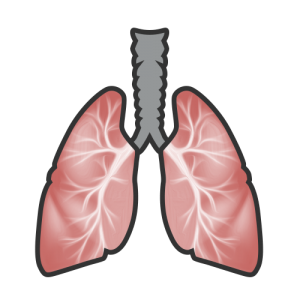 Asthma, explained by dysfunction of the autonomic nervous system: the “other-way-round” theory.
Asthma, explained by dysfunction of the autonomic nervous system: the “other-way-round” theory.
Now as a full time practitioner doing postgraduate work in the autonomic nervous system, I would have treated my 6-year old asthmatic self quite differently, knowing what I now know. After all those hospital visits and years of drugs, I would have suggested other ideas to my mother.
- Asthma is driven by a hyperactive parasympathetic nervous system.
- Corticosteroids can have long term damaging effects on the body.
- Specific spinal adjustments are imperative in asthma management.
Nervous system control of the airways is not normal in asthmatic patients1. This creates “neurogenic inflammation”: bronchoconstriction, mucous secretion, coughing and wheezing because the bronchial walls have become too big for air to easily pass through.
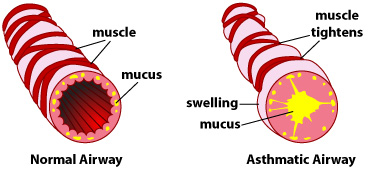
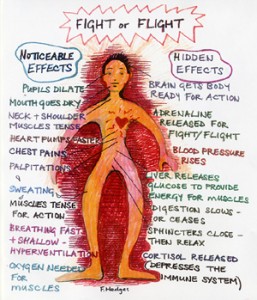 To understand what I’ve dubbed the “other-way-round” theory, you need to know what sympathetic nerves do and what parasympathetic nerves do. General convention describes the sympathetic nervous system as the fight/flight response (click image to enlarge) and the parasympathetic system as resting/digesting, which is what most people know. While this is true, it is only true for the end-organs that these nerves fire to. Both systems have the ability to turn things on or turn things off.
To understand what I’ve dubbed the “other-way-round” theory, you need to know what sympathetic nerves do and what parasympathetic nerves do. General convention describes the sympathetic nervous system as the fight/flight response (click image to enlarge) and the parasympathetic system as resting/digesting, which is what most people know. While this is true, it is only true for the end-organs that these nerves fire to. Both systems have the ability to turn things on or turn things off.
You’d think because of the sing-song rhyme that sympathetic nerves would cause constriction, and parasympathetic nerves dilation? When it comes to the airways, it’s the “other-way-round”. read more…
Bedwetting or Nocturnal Enuresis
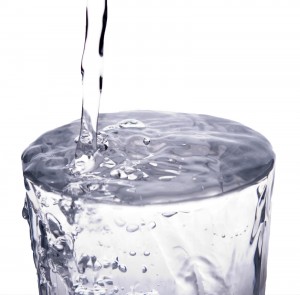 Nocturnal enuresis means uncontrolled urination at night after the age of 5 years.
Nocturnal enuresis means uncontrolled urination at night after the age of 5 years.
This article highlights brain-based reasons for bedwetting, outside of pathological conditions such spina bifida, kidney disease or urethral obstructions. It’s for the parents who have already tried alarm clocks, reduced fluid intake before bed time, done reward charts, watched their child go to the toilet before bed or may have even considered medication.
There are 2 types of nocturnal enuresis: 1. The child who has never been dry for more than a few months at a time (primary nocturnal enuresis); and 2. The child who has been completely dry for more than 6 months and then starts to wet the bed again (secondary nocturnal enuresis).
In the context of brain-based bedwetting, the mechanisms for either would be similar, and would generally respond favourably to chiropractic care.
The 3 commonalities in a child with brain-based bedwetting are as follows:
- A child who is sensitive in nature or has experienced recent emotional events.
- A child with poor sleep rhythms – disturbed, restless, or very deep sleep.
- A child displaying retained primitive reflexes (see below).
Sleep disruptions in children are usually a normal symptom of central nervous system development but enuresis might be sign of immaturity of the sleep mechanism. Sleep is coordinated by the brain, its emotional centres, the circadian cycle and hypothalamus, the brainstem and autonomic nervous system. It’s a complex overlay of multiple controls, which is why there is never one straight forward answer. read more…
Chronic Fatigue Syndrome
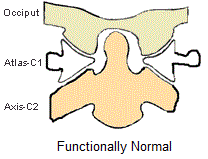 The term “subluxation” means “minor misalignment”, however the affects on the human body as a result of a subluxation of either the first or second cervical vertebra (atlas or axis) with respect to the skull can be far from “minor”.
The term “subluxation” means “minor misalignment”, however the affects on the human body as a result of a subluxation of either the first or second cervical vertebra (atlas or axis) with respect to the skull can be far from “minor”.
Upper cervical specific is becoming more widely searched for and recognised as a safe and effective technique for correcting upper neck subluxations.
Practicing upper cervical specific has given me the privilege of looking after many who fly into Auckland for care. Some of the stories are unbelievable.
Last month I worked with a couple who flew up from Christchurch to stay for a week. 8 years ago the husband was hit on the back of a head by a crate at work. X rays were “normal”. MRI was “normal”. Function was not normal. The impact a subluxation has on the human experience is most apparent in these cases when symptoms, over time, become extreme.
Minor atlas/axis misalignment alters the nervous system in the following ways:
- Reduced frequency of nerve firing to the brain
- Reduced oxygenated blood flow to the brain
- Decreased/increased muscle activity on one side of the body
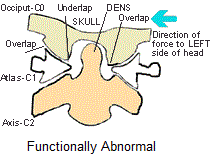 Over an 8 year period the husband lost his ability to work. He started getting chronic daily headaches. He became so light sensitive he had to wear sunglasses all the time, even indoors. He became chronically fatigued and lost all strength in his dominant hand. His concentration dropped through the floor and mental processes slowed. Ultimately, after seeing 25 medical practitioners, he was diagnosed with the problem being “all in his head”. Not one considered the spine.
Over an 8 year period the husband lost his ability to work. He started getting chronic daily headaches. He became so light sensitive he had to wear sunglasses all the time, even indoors. He became chronically fatigued and lost all strength in his dominant hand. His concentration dropped through the floor and mental processes slowed. Ultimately, after seeing 25 medical practitioners, he was diagnosed with the problem being “all in his head”. Not one considered the spine.
A fit, active, middle-aged man losing his life before his eyes with ACC, doctors and a psychologist telling him he’s, quote, making it up, unquote.
We worked together for 2 hours a day. By the end of the week, he had a headache-free day for the first time; he could momentarily take his glasses off indoors; and he gave me the biggest bear-grip handshake with his dominant hand. We were all moved to tears.
Chronic fatigue is often misdiagnosed and rarely is attention paid to the spine and brain. Altered nervous system integrity will create fatigue. This is due to changes in the brain’s fuel efficiency, the body’s oxygenation, and overall muscle tone.
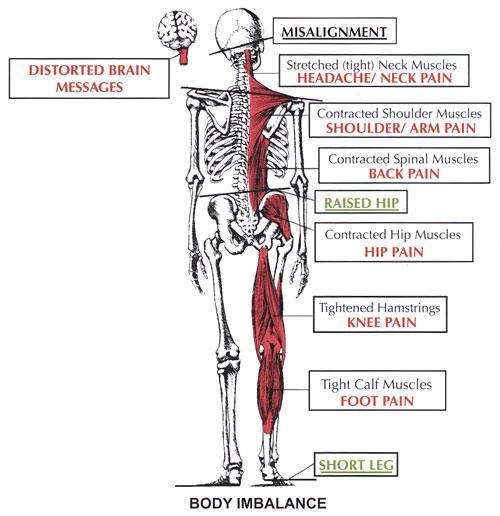
Other factors can contribute to chronic fatigue: diet, gut, stress, viral, past trauma, smoking, weight, breathing etc. However all roads lead to brain. Problems are proportional to the amount of pressure placed on the nervous system. This will be reflected in posture as the body’s mechanical levers start to fail. Subluxations will be reinforced, and the cycle of negative feedback into the brain will continue, leading to more fatigue and decreased adaptability. read more…
Iliotibial Band Syndrome
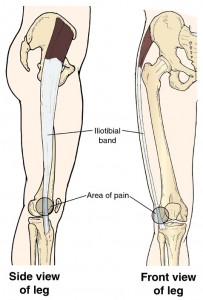 The iliotibial band is a common source of perceived back, hip and groin pain. While people often associate iliotibial band (ITB) syndrome with runners, it’s a frequent occurrence amongst those who don’t run too.
The iliotibial band is a common source of perceived back, hip and groin pain. While people often associate iliotibial band (ITB) syndrome with runners, it’s a frequent occurrence amongst those who don’t run too.
The ITB is a strong, thick band of fibrous tissue that runs along the outside of the leg. It starts at the hip and runs along the outer thigh and attaches to the outside edge of the shin bone (tibia) just below the knee joint.
Low back and hip pain can be challenging to diagnose because there are multiple sources of pain referral and with the way pain receptors are wired in the low back (being wide apart) a person cannot always accurately perceive where the source of the pain is, although they might feel it in their hip or groin.
The old understanding is that the ITB becomes inflamed as it runs over the leg bone due to friction. This doesn’t really happen because the ITB itself is extremely rigid and resistant to stretch – it lengthens less than 0.2 percent with a maximum voluntary contraction.
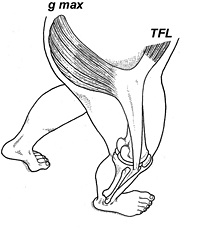 The role of the ITB is to flex, lift sideways and internally rotate the leg. It’s fibrous tissue splits into two parts at the top of the hip: 1. Melding with the gluteal muscles at the back (g max) and 2. Joining the tensor fasciae latae muscle at the front (TFL).
The role of the ITB is to flex, lift sideways and internally rotate the leg. It’s fibrous tissue splits into two parts at the top of the hip: 1. Melding with the gluteal muscles at the back (g max) and 2. Joining the tensor fasciae latae muscle at the front (TFL).
Tension and compression of the ITB occurs when these two connections at the top of the band become weak or don’t have appropriate nerve firing from spine and brain.
Weakening of the gluteal muscles can happen in a number of ways: Sitting for long periods of time, crossing legs, or standing with hip cocked to one side. Gluteal muscles also weaken through physiological and mental stress. Parts of the nervous system responsible for handling stress weaken the body’s posture and the pelvis can lose strength and form. See weak hip abductors (B) versus normal hip abductors (A). This problem can refer or create low back pain, hip pain, or groin pain. read more…
Aches and Pains
Happy with your lot in life? Let us help you create a new normal.
You only know what you know. Clients sometimes think they have a really serious problem, or have been told it’s degeneration, or aging. They accept this as “normal”.
In reality the problem might be quite simple. A thorough neurological exam determines what the problem is, how serious it is, and the best course of action. Results create a “new normal” and clients then wonder why they put up with their particular issue for so long.
The dots represent two people. One has symptoms, the other doesn’t. In order to have symptoms, health has to deteriorate over time. Our objective is to turn the direction of your health around so it moves toward healthy. With the relief of symptoms, is a person healthy or just not sick? Just because there are no symptoms doesn’t mean that the person is healthy. Healthy is the continuous movement of health in the right direction.
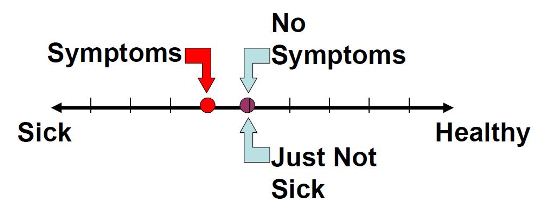
We’ve posted some fantastic cases over the years, but everyday aches and pains can be quite debilitating too. We celebrate these resolutions alongside the “miracle” stories too because there’s nothing better than feeling good. It spills over into every other aspect of one’s life.
Like going to the dentist, tell your friends this year to have a spine and nervous system check up to help them create their own new normal. Life is meant to flow with ease.
Hormonal Headaches
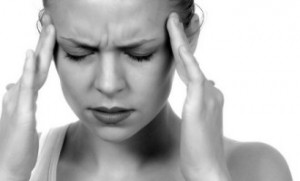 Some controversy has been sparked recently about the myth of PMS or premenstrual stress. A literature review from Otago University intended to tease apart the cultural bias that if a woman is distressed or anxious, it’s directly linked to her menstrual cycle. Of 47 English language studies identified, 40% found no association of mood with any phase of the menstrual cycle and only 15% found an association of negative mood with the premenstrual phase.
Some controversy has been sparked recently about the myth of PMS or premenstrual stress. A literature review from Otago University intended to tease apart the cultural bias that if a woman is distressed or anxious, it’s directly linked to her menstrual cycle. Of 47 English language studies identified, 40% found no association of mood with any phase of the menstrual cycle and only 15% found an association of negative mood with the premenstrual phase.
The argument is that there may be other explanations for a woman’s mood swings: social or physical processes; home or work life. While this is true and every problem is multi-factorial, the reality is that women have a uterus and this can cause some issues every month. The hormones estrogen and progesterone, which play key roles in regulating the menstrual cycle and pregnancy, may affect headache-related chemicals in the brain. A drop in estrogen before a period can spark pain processes. This is called an estrogen-withdrawal headache.
 Estrogen dominates the first half of the menstrual cycle and prepares the ovaries for ovulation. It causes buildup of the endometrial lining of the uterus, peaking at mid-cycle (ovulation). Progesterone is not produced by the ovaries until after ovulation. Progesterone is responsible for maintaining and ripening the uterine lining so that it is receptive to implantation should pregnancy occur. If no pregnancy occurs, a drop in progesterone (and estrogen) levels activates menses to flush out the uterine lining and causes the body to eliminate the extra nutrients it has stored – and the cycle begins again. read more…
Estrogen dominates the first half of the menstrual cycle and prepares the ovaries for ovulation. It causes buildup of the endometrial lining of the uterus, peaking at mid-cycle (ovulation). Progesterone is not produced by the ovaries until after ovulation. Progesterone is responsible for maintaining and ripening the uterine lining so that it is receptive to implantation should pregnancy occur. If no pregnancy occurs, a drop in progesterone (and estrogen) levels activates menses to flush out the uterine lining and causes the body to eliminate the extra nutrients it has stored – and the cycle begins again. read more…
